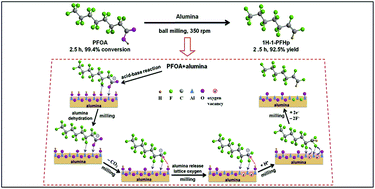Alumina-mediated mechanochemical method for simultaneously degrading perfluorooctanoic acid and synthesizing a polyfluoroalkene†
Abstract
The design of large-scale processes for disposing harmful perfluorooctanoic acid (PFOA) is an important issue, since it was listed as a persistent organic pollutant in 2015. In this work, we developed an alumina-mediated solid-state mechanochemical (MC) method to simultaneously degrade PFOA and synthesize 1H-perfluorohept-ene (1H-1-PFHp), which is a valuable organofluorine block. A 2.5 h MC treatment resulted in a nearly complete removal (99.4%) of PFOA and a high yield (92.5%) of 1H-1-PFHp. In this transformation, the surface hydroxyl groups on alumina are critical for anchoring the PFOA molecules during the defluorination reaction, and the milling process promotes the dehydration of alumina to produce reactive Lewis acid sites for activating the C–F bonds. Moreover, the high energy ball milling initiates simultaneously the release of lattice oxygen from alumina, producing oxygen vacancies (in alumina) and free electrons, the latter of which can induce the breakage of C–F bonds via a reductive pathway. The combination of the mechanocaloric effect and the triple roles of alumina drives PFOA to a controlled defluorination. This MC process shows promising applications in the green treatment of PFOA solid wastes.



 Please wait while we load your content...
Please wait while we load your content...